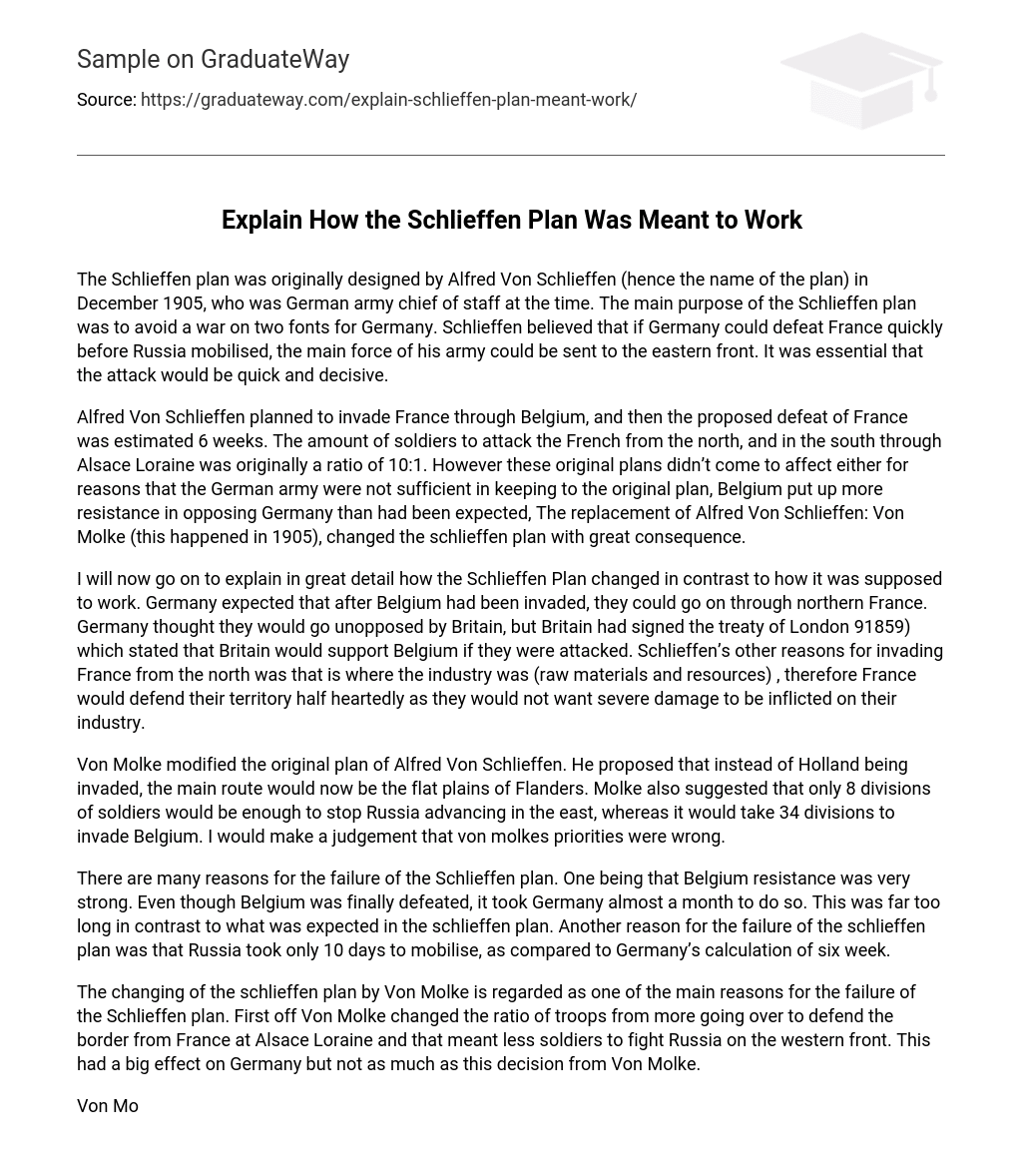Alfred Von Schlieffen, the German army chief of staff in December 1905, devised the Schlieffen plan with the aim of avoiding Germany’s involvement in a war on two fronts. The primary goal of this plan was to rapidly conquer France before Russia could mobilize its forces, allowing most of the German army to concentrate on the eastern front. The effectiveness of this offensive depended on its velocity and resoluteness.
Alfred Von Schlieffen’s plan involved invading France by going through Belgium. The goal was to defeat France within 6 weeks. Originally, the plan was to have a ratio of 10 soldiers attacking France from the north and in the south through Alsace Loraine. However, the German army was unable to stick to the original plan, and Belgium resisted Germany more than anticipated. In addition, the replacement of Alfred Von Schlieffen with Von Molke in 1905 had significant consequences for the Schlieffen plan.
This paragraph discusses how the Schlieffen Plan deviated from its intended course. Germany originally planned to invade Belgium and then proceed through northern France. However, they did not anticipate opposition from Britain, who had pledged support to Belgium through the treaty of London (1859). Additionally, Germany reasoned that attacking France from the north was a strategic choice due to the presence of industry and valuable resources in that region. It was believed that France would not put up a strong defense in order to protect their industrial assets from significant damage.
Von Molke made modifications to Alfred Von Schlieffen’s initial strategy, which involved relocating the primary route from Holland to the level plains of Flanders. Moreover, Molke suggested that only 8 divisions would be enough to impede Russia’s progress in the east, while invading Belgium would necessitate 34 divisions. Considering these choices, I assert that von Molke’s focus was misdirected.
The failure of the Schlieffen plan can be attributed to multiple factors. Firstly, the resistance in Belgium posed a substantial obstacle for Germany. Although Germany eventually defeated Belgium, it took them almost a month to do so, which was longer than what the Schlieffen plan had predicted. Secondly, Germany underestimated how quickly Russia would mobilize their forces; it only took Russia 10 days instead of the expected six weeks.
One of the main reasons for the failure of the Schlieffen plan was the alteration made by Von Molke. Firstly, Von Molke adjusted the ratio of troops, resulting in a decrease in the number of soldiers assigned to defend the border from France at Alsace Loraine. Consequently, fewer troops were available to fight Russia on the western front. While this decision had a significant impact on Germany, it was not as crucial as the change implemented by Von Molke.
Von Molke made the decision to modify their route to only pass through Belgium, rather than going through two countries to reach their destination. Belgium put up a strong resistance against Germany, effectively slowing down the progress of the schlieffen plan. If the original plan, which involved going through both Holland and Belgium, had been followed, this outcome may not have occurred.
The Schlieffen plan’s failure is largely attributed to Von Molke’s numerous deviations from its original form, ultimately leading to its downfall.
B) The stalemate on the western front during the great world war was caused by various factors. One major reason was the failure of the Schlieffen plan, which was a result of trench warfare being utilized. Both sides dug deep trenches, enabling ground-level combat. These trenches were designed strategically in a zig-zag formation to hinder easy firing between them, making it like a maze for potential invaders. Barbed wire fortified each section of the trenches – reserve, support, communication, and front line – greatly obstructing invasion attempts.
The development of stalemate on the western front can be attributed to the defensive nature of artillery used in the war. Various weapons, such as the lee Enfield rifle, long range guns, poison gas, mines, and tanks, were employed by both sides. Consequently, it is not surprising that breaking through enemy trenches became a challenging task for both countries. As a result of continuous artillery fire, men were unable to make any progress and suffered heavy casualties. Additionally, Falkenhayn’s defensive strategy, which involved patiently gaining land through the use of ammunition, created conflict with Hindenburg and Ludendorff, who favored a more offensive approach.
Another reason for the stalemate on the western front was the tank’s failure. The tank was initially praised by Lloyd George as a “war winning machine”, and this optimism was shared by many, including Douglas Haig. However, when the tanks were put to the test in warfare, they did not meet the high expectations. Many tanks broke down before reaching their starting posts, while others were abandoned due to the difficult terrain. Ultimately, the tanks did not provide any advantage and often ran over and scattered barbed wire, making it even more challenging for soldiers to cross no man’s land.
Ultimately, the impasse on the western front primarily resulted from the strategy of trench warfare, a defensive style of warfare that prevented either side from making progress.





